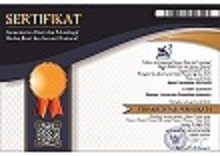EVALUATION OF STREET SPACE UTILIZATION AS PLAYABLE STREET IN CHILD-FRIENDLY VILLAGE LELES CONDONGCATUR
Abstract
The unavailability of play space in Indonesian villages has often driven children to use the street as a play space. This has also been practiced in developed countries, but has been more planned and designed to create a sense of safety and comfort for children. Often street space can be permanently closed off to allow for optimal placement of children's play equipment. In the context of architecture, the concept of using street space as a space that can be played by children is called playable street. One of the settlements that has applied the concept of playable street until it received the predicate of the best child-friendly village by the local district government is the Child-Friendly Village (CFV) Leles Condongcatur. Therefore, Delima Street in CFV Leles Condongcatur was chosen as the object of research. This research aims to find out the application of the playable street concept that has been done to be evaluated so that the strengths and weaknesses can be a lesson to design a playable street more optimally. The method used in this evaluation is observation to find out the description of the physical elements which are then further analyzed based on the literature study that has been done. In CFV Leles Condongcatur, the concept of playable street is temporary and only done normatively (not architecturally) such as the use of portals and banners as vehicle stop signs, road space that is only colored with paint, and the absence of game equipment in the playable street. Whereas Delima Street in CFV Leles Condongcatur is appropriate for playable streets because the traffic density is quite low.
Full Text:
PDFReferences
Anggeriyane, E., Yunike, Mariani, Susanto, W. H. A., Halijah, Sari, I. N., Handian, F. I., Elviani, Y., Suriya, M., Iswati, N., & Yulinati, N. R. (2022). TUMBUH KEMBANG ANAK (M. Sari, Ed.; 1 ed., Vol. 1). PT. GLOBAL EKSEKUTIF TEKNOLOGI.
Darisman, M. (2019, September 18). Mengunjungi Kampung Ramah Anak Terbaik di Sleman, Yogyakarta. KumparanNews. https://kumparan.com/kumparannews/mengunjungi-kampung-ramah-anak-terbaik-di-sleman-yogyakarta-1rt3zVzZiJq
Dewiyanti, D., Natalia, T. W., & Hertoety, D. (2022). Identifikasi Pilihan Tempat Bermain Anak pada Lingkungan Permukiman Terencana dan Tidak Terencana. Jurnal Lingkungan Binaan Indonesia, 11(4). https://doi.org/10.32315/jlbi.v11i4.61
Ekawati, S. A. (2015). Children – Friendly Streets as Urban Playgrounds. Procedia - Social and Behavioral Sciences, 179. https://doi.org/10.1016/j.sbspro.2015.02.413
Gencer, T. E. (2017). The Relationship Between Child and Urban Safety : Child-Friendly Safe Cities. The Online Journal of Science and Technology, 7(4).
Gospodini, A., & Galani, V. (2006). Street space as playground Investigating children’s choices. International Journal of Sustainable Development and Planning, 1(3). https://doi.org/10.2495/SDP-V1-N3-353-362
Gunawan, M. F. (2024). Potensi Jalan dan Taman Bermain Sebagai Ruang Bermain Anak-anak. SADE : Jurnal Arsitektur, Planologi dan Teknik Sipil, 3(1), 1–7. https://doi.org/10.29303/sade.v3i1.53
Kementerian Pemberdayaan Perempuan dan Perlindungan Anak. (2023, November 25). Menteri PPPA: Ruang Bermain Ramah Anak adalah Bentuk Keseriusan Daerah Penuhi Hak Tumbuh Kembang Anak. Kementerian PPPA. https://www.kemenpppa.go.id/page/view/NDg5Nw==
Krysiak, N. (2019). Designing Child-Friendly High Density Neighbourhoods (1 ed., Vol. 1). Cities for Play, funded by the Winston Churchill Foundation. https://90ffb89e-d990-4f1a-90f3-7974ef8ea8c5.filesusr.com/ugd/534edb_5e8553bb853d40228da3083a0ed1eede.pdf
Manurung, P. (2016). DAMPAK KETERBATASAN RUANG BERMAIN TERHADAP AKTIVITAS BERMAIN ANAK. JURNAL PERSPEKTIF ARSITEKTUR, 11(02), 261–269. https://e-journal.upr.ac.id/index.php/JTA/article/view/1984
Nurulhuda, D., Nirawati, M. A., & Mustaqimah, U. (2019). Desain Arsitektur Ramah Anak Pada Bangunan Paud Untuk Merespon Perilaku Anak Usia Dini. Senthong, 2(1).
Peraturan Walikota (PERWALI) Kota Yogyakarta Nomor 71 Tahun 2018 tentang Kampung Ramah Anak, Pub. L. No. 71 (2018).
Rolalisasi, A., & Soemarwanto, D. (2019). Gang sebagai Tempat Aktivitas di Permukiman Perkotaan Referensi Kampung di Kota Surabaya. NALARs, 19(1). https://doi.org/10.24853/nalars.19.1.19-28
Sari, I. D. K. (2019, Oktober 14). Kampung Ramah Anak RW 18 Leles Condongcatur: Punya Satgas PPA Tingkat RW. wargajoogja.net. https://wargajogja.net/sosial/kampung-ramah-anak-rw-18-leles-condongcatur-punya-satgas-ppa-tingkat-rw.html
Sholikah, R. J., & Subaidi, S. (2022). Pembangunan Lingkungan Ramah Anak Terkait Pemenuhan Hak Anak Pada Masa Pandemi di Kampung Leles, Condongcatur, Depok, Sleman, DIY. Lisyabab : Jurnal Studi Islam dan Sosial, 3(1). https://doi.org/10.58326/jurnallisyabab.v3i1.107
Siregar, I., & Sriyolja, Z. (2020). Rancangan ruang bermain anak yang kreatif dan edukatif dengan pemanfaatan lahan fasilitas umum. Dinamika Lingkungan Indonesia, 7(2). https://doi.org/10.31258/dli.7.2.p.111-115
Stille, K. (2021, Maret 1). Inclusive Public Spaces. Urban Design Group. https://www.udg.org.uk/publications/articles/inclusive-public-spaces
Syanuna, S., & Darmawati, R. (2023, Maret 5). PERPINDAHAN RUANG BERMAIN ANAK DARI LAPANGAN KE JALAN PERMUKIMAN DI DESA KERTIJAYAN KABUPATEN PEKALONGAN. SAKAPARI 2022 #SERIES 9.
Tranter, P. and Doyle, J. (1996). Reclaiming the Residential Street As Play Space. Dalam International Play Journal (Vol. 4, hlm. 91–97). https://www.researchgate.net/publication/286786261_Reclaiming_the_residential_street_as_play_space
Undang-undang (UU) Nomor 38 Tahun 2004 tentang Jalan, Pub. L. No. 38 (2004).
Wardiningsih, S., Sitinah, S., Maida, S. T., K., R. I., & Sinambela, R. (2021). Pemanfaatan Gang sebagai Ruang Edukasi dan Interaksi Anak pada RW 02 Kelurahan Paseban Jakarta Pusat. Jurnal Karya untuk Masyarakat (JKuM), 2(1). https://doi.org/10.36914/jkum.v2i1.488
Yusuf, M. (2023). KONSEP PENATAAN JALAN LINGKUNGAN DESA SEBAGAI TEMPAT BERMAIN ANAK USIA DINI BERDASARKAN PERSEPSI ORANG TUA. DEARSIP : Journal of Architecture and Civil, 3(01). https://doi.org/https://doi.org/10.52166/dearsip.v3i01.4274
DOI: https://doi.org/10.17509/jaz.v8i1.76950
Refbacks
- There are currently no refbacks.
Copyright (c) 2025 Mutia Mawarani, Yohanes Basuki Dwisusanto

This work is licensed under a Creative Commons Attribution-ShareAlike 4.0 International License.






